28.10.2016
.
Chinese scientists decode technology on Tiangong-2
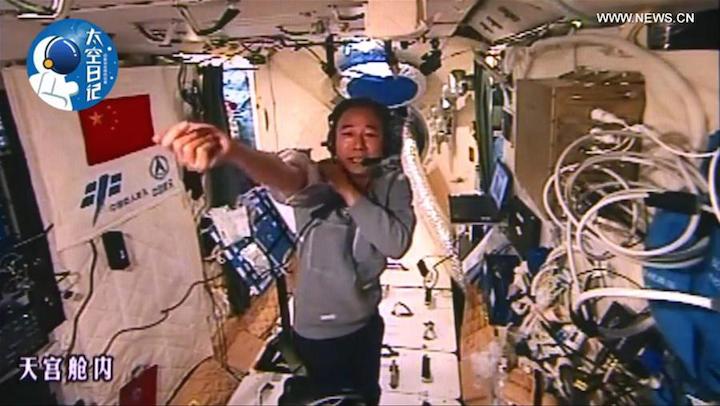
As China's space exploration continues to grab national attention, scientists on Thursday decoded an important technology on China's space lab Tiangong-2.
Scientists with the Lanzhou Institute of Physics have created important equipment on the space lab, including the Stirling cryocooler, which is used to lower the temperature of superconductive devices.
"The Stirling cryocooler for Tiangong-2 is like a huge refrigerator," said Sun Shuze with the institute. "While a normal fridge can bring temperatures down to minus 20 degrees Celsius, the Stirling cryocooler can make it to below minus 200 degrees Celsius."
Sun expects the technology will be applied in civil use in the future.
"If, for example, a mechanic wants to fix the chassis of a car, which usually has high temperatures, we can create a jacket made with Stirling cryocooler and make it cool down there very soon," he added.
Scientists with the institute have already developed an electric generator for civil use with the Stirling technology. With the generator, one can generate electricity with heat sources 300 degrees to 400 degrees Celsius.
"I hope that while such technology contributes to China's space development, it will also help people live better lives," he said.
Tiangong-2 was launched in September, and the Shenzhou-11 spacecraft last week took two astronauts to a 30-day mission in the space lab. They will conduct more than a dozen scientific experiments, most of them in cutting-edge fields of exploration, preparing for the construction of a more complicated space station.
Quelle. Xinhua
---
Shenzhou-11: Recursive space propaganda
 Footage of Xi Jinping's Long March victory anniversary speech and the crew aboard Tiangong-2. (Photo: CCTV/framegrab)
Footage of Xi Jinping's Long March victory anniversary speech and the crew aboard Tiangong-2. (Photo: CCTV/framegrab)The use of outer space activities for propaganda goes right back to the beginning of the Space Age. The launch of Sputnik 1 had a deep psychological effect on the United States, and drew a strong response. Khrushchev pushed the Soviet Union space program to secure a number of ‘firsts’ in space to push the notion of Soviet technical, economic and social superiority, while US President Kennedy announced the Apollo program to, in part, show it was America that lead the way.
China’s growing space program, like all others, is driven by a range of economic, scientific, developmental, military and other factors, the ruling Communist Party of China (CPC) is, too, also very aware of its political value.
Putting something into orbit, however mundane it may appear these days, is an incredible technological feat, even more so if it involves humans being onboard. Doing so demonstrates not just technical prowess but also economic might, political stability and brings a sense of immense pride and reinforces a sense of unity.
China’s achievements in space have been promoted in popular culture through films, postcards, stamps, public competitions to name missions and, starting this year, a national ‘Space Day’ celebration, as well as the slogan ‘Space Dream’ being used to tie the program to Chinese leader Xi Jinping’s own ‘China Dream’ vision.
Astronauts are also involved, and often make public appearances around the country. Liu Yang, China’s first female in space aboard Shenzhou-9 in 2012, is widely celebrated, and has stated that women can "hold up half of space”, a twist on People’s Republic of China founder Mao Zedong's remark that "Women hold up half the sky”.
Meanwhile, nearly 400 kilometres above Earth, the ongoing Shenzhou-11 mission recently participated in a move that was less inclusive, but apparently important to the CPC.
Xinwen Lianbo is state broadcaster for China Central Television’s flagship news programme, which, The Economistsays, focuses on the latest activities of China’s leaders above what may be bigger stories. Featuring a decades-old theme and formula, it gets the Party's message out to around 150 million people each evening.
On Friday China marked the 80th anniversary of the victory of the Long March, the near-mythical 6,000 mile journey Communist forces embarked on in 1934 to escape encirclement by nationalist forces, and which also gives the name to China’s space launch vehicles.
The occasion, led by a speech from Mr Xi, is perfect fare for Xinwen Lianbo.
For this event Jing Haipeng and Chen Dong, the Shenzhou-11 astronauts spending 30 days aboard the Tiangong-2 space lab, used the Tianlian-1 satellite constellation to tune in to Xi Jinping’s speech broadcast on Xinwen Lianbo, a fact that was widely stated by media.

Above: Jing Haipeng and Chen Dong applaud aboard Tiangong-2.
The next day, Xinwen Lianbo rolled around at 19:00 Beijing time to show footage of Jing and Chen watching the show, their stamina aided by microgravity, providing a recursive view of China’s political messages, and presumably the astronauts a view of themselves:
Wu Dawei, director of the Medical Engineering Office of the Astronaut Centre of China, told CCTV that she thinks the “spirit demonstrated by the Red Army Soldiers during the march is similar to that of our Chinese astronauts”.
Wu added that Xinwen Lianbo is just part of the program list prepared for the astronauts in space, but others will be uplinked, “especially the ones they are interested in”.
Wang Yaping, the second woman among China’s astronaut recruits, performed a space physics lecture from orbit aboard Tiangong-1 in June 2013 during China’s previous crewed mission, Shenzhou-10, transmitting live to 80 million school kids. For Shenzhou-11, the astronauts are on the receiving end.
---
Shenzhou-11 silkworms start spinning cocoons on space lab
The experiment is one of three designed by Hong Kong middle school students, which are being carried out by the two Shenzhou-11 Chinese astronauts Jing Haipeng and Chen Dong.
While astronauts face extremely tough qualification and selection rounds, it is also apparently tough for silkworms to make the cut, with the six being chosen from 4,000 candidates.
Zhao Danni, an engineer from No. 529 factory of China Academy of Space Technology (CAST), the research body's satellite manufacturing plant, told CCTV that the specially cultivated silkworms are now in separate capsules, each containing mulberry leaf paste.
Once back on Earth, the growth and development of the 'Shenzhou-11 Six' will be compared to those of the silkworms living and developed in natural terrestrial conditions, and study the effects of microgravity on the qualities of the silk produced.
This is not China's first space silkworm adventure. An earlier experiment, designed by students from Beijing Jingshan Middle School, was placed on the 22nd of China's Fanhui Shi Weixing retrievable satellite series launched in August 2005.
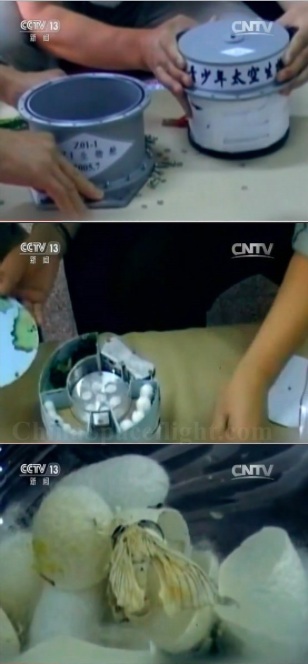
The experiment had earlier been placed aboard the Columbia shuttle which launched in January 2003 as part of a NASA project to solicit experiments from students around the world, but this was not completed due to the shuttle re-entry disasterin February that year.
Tests for space station
Jing and Chen are also undertaking medical testing on themselves using the ultrasound equipment on board Tiangong-2 to scan their cardiovascular and pulmonary systems.
The crew will also monitor bone and muscle degradation, as well as any alterations to their eyesight as part of preparations for a large, modular Chinese space station.
Quelle: gbtimes
-
Update: 29.10.2016
.
Shenzhou 11 crew began orbital life on Tiangong 2
The 49-year-old spaceflight veteran Jing Haipeng and 37-year-old first-time flyer Chen Dong entered the Tiangong 2 space laboratory on Wednesday 19 October, following a successful automated rendezvous docking. They were launched to orbit aboard their Shenzhou 11 spacecraft vehicle two days before, from the Jiuquan Satellite Launch Centre. Shortly after entering Tiangong 2, the two astronauts entered busy work routine onboard the space laboratory.
On Day 2 (20 October) of the station occupation, at 22:21 CST (14:21 UTC), under the command of mission control, the Tiangong 2-Shenzhou 11 complex carried out an orbital manoeuvre burn to lower its altitude by about 4 km, to 380 km. The complex also made a 180° turn in the azimuth direction, so that the Tiangong 2 module could resume its ‘normal’ flying position, with the docked Shenzhou 11 vehicle at front and the space laboratory’s engine thrusters towards back.

According to the Chinese state media, the two astronauts established a living and working routine in space, with an 8-hour working day, for six days a week. The time onboard the space laboratory has been set to the China Standard Time (Beijing time, UTC+8), in order to match the time zone at the mission control centre in Beijing.
The Chinese state media published a space journal kept by commander Jing Haipeng, which offered a glimpse of the crew’s busy life on orbit. In his journal, Jing noted a very busy first day onboard the space laboratory, with the work continuing well into late night past 22:00. The crew did not even have time for a hot meal and only took some snacks at breakfast and lunch. He also noted the improvement in living conditions compared with the previous space laboratory Tiangong 1, where he spent 10 days onboard in June 2012.
Over the coming weeks, the two astronauts will carry out a total 14 scientific and engineering experiments. On day one, they planted the seeds for a romaine lettuce growing experiment, and also prepared the silkworm cultivation experiment designed by Hong Kong students.

Chinese media also reported that the two astronauts watched live Chinese Central Television (CCTV) news programme in the evening of 21 October. According to Yang Liwei, China’s first man in space and now director of the Astronaut Centre of China (ACC), the Tiangong 2 space laboratory is capable of receiving live television programmes including news and sport matches.
On Day 5 (23 October), at 07:31 CST, the Shenzhou 11 crew released a CubeSat named Banxing 2 (BX-2), which was carried into space by Tiangong 2. Fitted with a 25-megapixel digital camera, the 47 kg satellite will capture orbital view of Tiangong 2-Shenzhou 11 and also demonstrate orbital flight in formation with the spacecraft complex. Its smaller sibling BX-1 was released by the Shenzhou 7 mission in September 2008, which Jing Haipeng also flew.



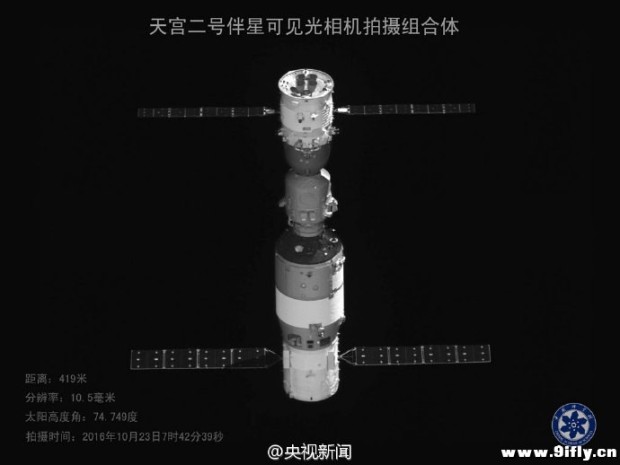
On Day 6 (24 October), commander Jing Haipeng celebrated his 50th birthday.
On Day 8 (26 October), Jing Haipeng tried a specially-designed suit for cardiovascular research in microgravity environment. In his email correspondence with the public, Jing said that he had adapted to life on orbit, spending on average six hours per day in sleep.
Quelle: CSR
----
Rückblick:
Shenzhou 11 successfully docked with Tiangong 2
The two astronauts of the Shenzhou 11 mission have entered the Tiangong 2 space laboratory to begin a 30-day mission to demonstrate medium- to long-term orbital living, following a successful rendezvous docking that took place at 03:24 CST on Wednesday 19 October (19:24 UTC on 18 October).
The Shenzhou 11 spacecraft carrying a crew of two astronauts was launched to orbit from the Jiuquan Satellite Launch Centre in the morning at 07:30 CST on Monday 17 October (23:30 UTC on 16 October).
About 10 minutes after lift-off, the spacecraft separated from the launch vehicle’s second-stage and was placed into a 197 km x 361 km initial parking orbit. Control of the spacecraft was officially handed over from the Jiuquan Launch Mission Control Centre to the Beijing Aerospace Control Centre (BACC).
About 5 hours 26 minutes into the flight, during its 4th orbit, Shenzhou 11 performed its first orbital elevation manoeuvre to enter a 366 km x 335 km orbit. This was followed by a second orbital elevation at the apogee of the 23rd orbit on 18 October, moving the spacecraft into a 376 km x 366 km orbit.
For the Shenzhou 11 mission, a total of five orbital elevation manoeuvres have been planned during the first 48 hours of orbital flight, in order to elevate the spacecraft to a 393 km orbit, on which Tiangong 2 was operating. In the previous Shenzhou missions, the rendezvous docking with the target vehicle (space laboratory) was performed on a 343 km orbit. The new flight sequence is a closer imitation of the rendezvous docking operation that will be used by the future manned space station.

Shenzhou 11 reached a position about 52 km away from Tiangong 2 in the early morning on 19 October, and the automated rendezvous and docking sequence was initiated. Under the guidance of the microwave and laser docking radars, the Shenzhou vehicle slowly closed in to Tiangong 2, which was flying in a ‘backside first’ position, with its front docking port pointing backwards in order for Shenzhou to perform a V-bar approach.
After pausing briefly at the 5 km, 400 m, 120 m and 30 m hold points, Shenzhou 11 was on final approach to Tiangong 2, with its crew on standby to take over using manual docking. The two vehicles made the first contact at 03:24 CST (17:24 UTC on 18 October). The docking mechanism of the two vehicles then pulled the two vehicles closer together to establish a hard-mate. By 03:34 CST, the two vehicles were fully joined. At 03:41 CST, the Mission Control Centre confirmed that the docking had succeeded.




At 03:46 CST, the Mission Control Centre gave the Shenzhou 11 crew the go-ahead to open the hatch to the spacecraft’s orbital module. It took about 90 minute for the two vehicles to achieve a balance on their internal pressure, in order for the crew to open the hatches on both sides of the docking port. At about 06:25 CST (22:25 UTC on 18 October), the hatch to Tiangong 2 was opened. Commander Jing Haipeng first entered the space laboratory module, while Chen Dong captured the whole process using a handheld camera. About 8 minutes later, Chen Dong also entered Tiangong 2.
After a brief communication with the ground via the video link, the two astronauts began preparation for their life on orbit in the temporary home over the next 30 days.
Quelle: CSR
-
Update: 31.10.2016
.
Photos of Tiangong-2 and Shenzhou-11 taken by accompanying satellite
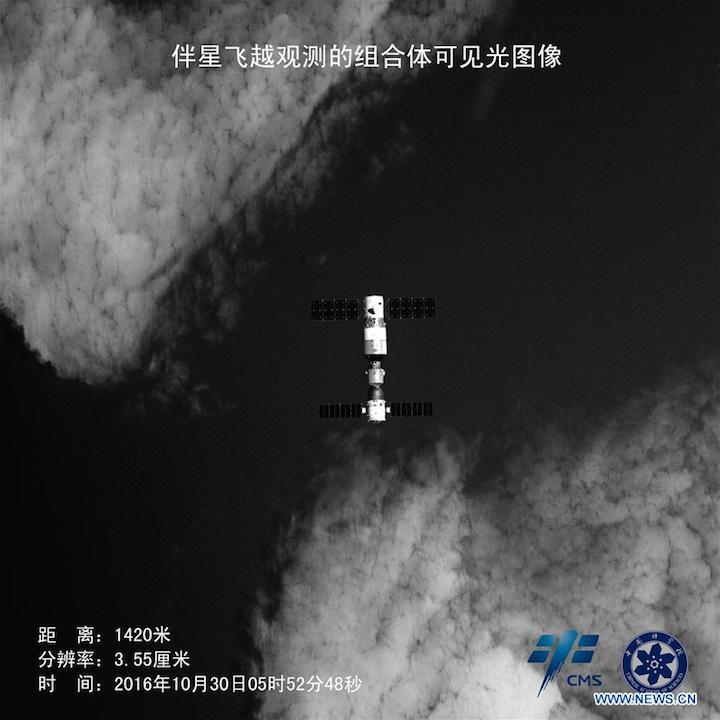
Photo taken by high-resolution camera shows Tiangong-2 space lab and Shenzhou-11 manned spacecraft on Oct. 30, 2016. An accompanying satellite orbited close to Tiangong-2 and Shenzhou-11 and took photos with the camera installed on it.
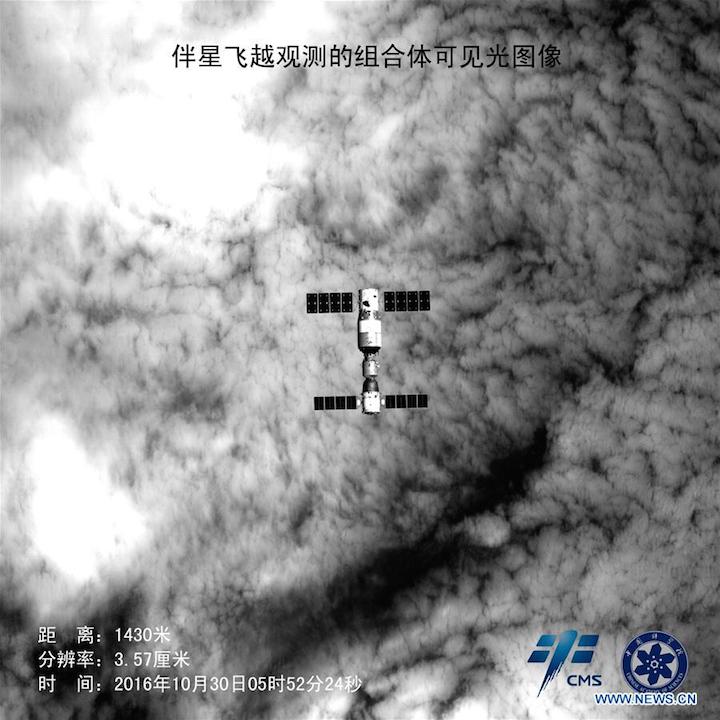
Photo taken by high-resolution camera shows Tiangong-2 space lab and Shenzhou-11 manned spacecraft on Oct. 30, 2016. An accompanying satellite orbited close to Tiangong-2 and Shenzhou-11 and took photos with the camera installed on it.
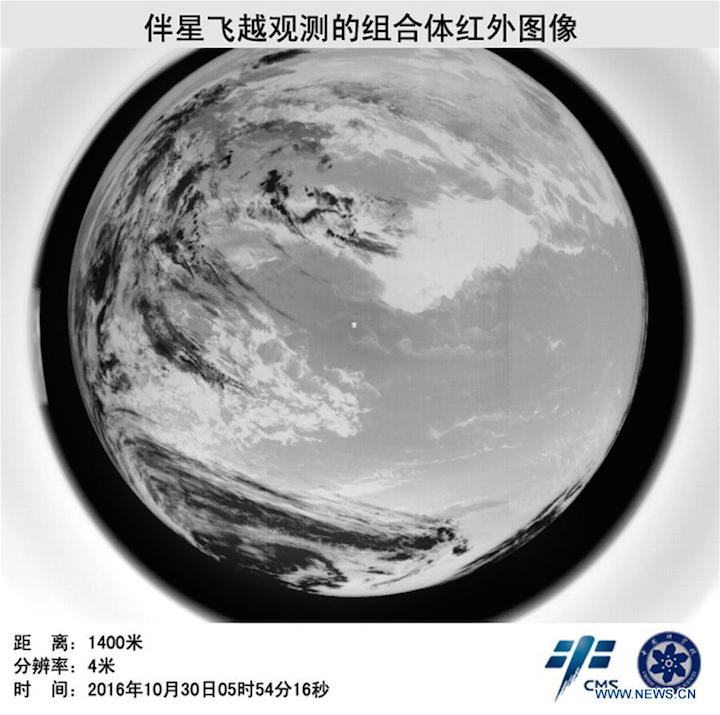
Panoramic photo taken by infrared fish-eye camera shows the Earth, Tiangong-2 space lab and Shenzhou-11 manned spacecraft(White dot in the middle) on Oct. 30, 2016. An accompanying satellite orbited close to Tiangong-2 and Shenzhou-11 and took photos with the camera installed on it.
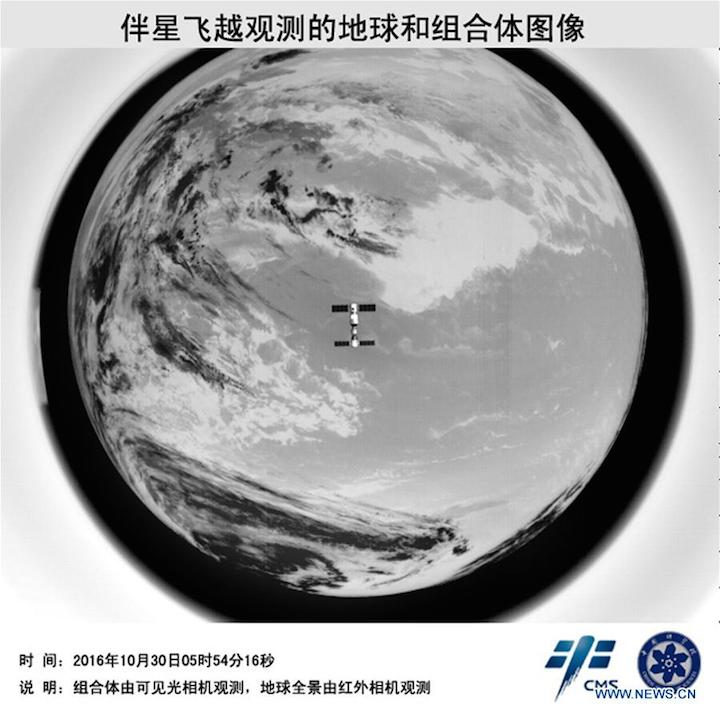
Composite photo taken by high-resolution and infrared fish-eye cameras shows the Earth, Tiangong-2 space lab and Shenzhou-11 manned spacecraft on Oct. 30, 2016. An accompanying satellite orbited close to Tiangong-2 and Shenzhou-11 and took photos with the camera installed on it.
Quelle: Xinhua
-
Update: 1.11.2016
.
China preparing Long March 7 rocket for Tiangong-2 refuelling mission
The second Long March 7, capable of lofting a 13.5-tonne payload to low Earth orbit, is expected to be shipped from North China to the southern island province of Hainan in early 2017.
From the Wenchang Satellite Launch Centre, the rocket will launch the Tianzhou-1 cargo ship into orbit, where it will dock with the Tiangong-2 space lab to test automated on-orbit refuelling.
This technology validation mission, currently expected in April, is crucial to China's plans to establish and maintain a large, permanently crewed space station in orbit.
The core module of the Chinese space station, Tianhe-1, is set to begin in 2018, with construction expected to be completed in the early 2020s.
The disclosure on the progress of the rocket came from Wang Xiaojun of the China Academy of Launch Vehicle Technology (CALT) and chief commander of the Long March 7 program on Sunday.
 Wang spoke to press at the China International Aviation and Aerospace Exhibition, the 11th edition of an annual show held in Zhuhai, Guangdong Province.
Wang spoke to press at the China International Aviation and Aerospace Exhibition, the 11th edition of an annual show held in Zhuhai, Guangdong Province.
On display in Zhuhai will be exhibits from the China Aerospace Science and Technology Corporation (CASC), the main contractor for the space program, of which CALT is a subsidiary.
Exhibits will include scale versions of the recently-launched Tiangong-2 space lab, as well as the orbiter, lander and rover for China's 2020 Mars mission.
Plans for Tiangong-2
Two astronauts launched on Shenzhou-11 are currently on board Tiangong-2 on China's longest crewed mission yet. They will return to Inner Mongolia in mid-to-late November.
China has hinted that there will be no further flights to Tiangong-2, meaning the Tianzhou-1 mission would merely be a test. It would, however, allow science experimentsonboard to continue running.
This refuelling technology cannot be simulated on the ground and it has to be operated in the microgravity space environment to prove function and reliability.
The Long March 7 completed a successful maiden launch in June 2016, laying a solid foundation for its future flights, Wang said.
The launch also tested a scale return capsule for a next-generation crewed spacecraft, designed to be capable of taking astronauts beyond low Earth orbit.
ABOARD TIANGONG-2, Hello everyone. I am the Xinhua space correspondent. The Shenzhou-11 crew would like to extend our greetings and best wishes to all Xinhua staff as the Xinhua News Agency marks its 85th founding anniversary on Nov. 7.
Today is Nov. 4, my 17th day onboard Tiangong-2. Since many people are curious about what we eat in space, today I would like to tell you about this.
Speaking of space food, many think that it lacks variety and tastes bad. However, this is not true. Let me tell you what we had today. In the morning, we ate seven types of food, including porridge, coconut bread, quail eggs and pickles. We had eight choices at lunch, including mixed fried rice, fried noodles with meat, stewed beef with potato and nori and egg soup. There were eight dishes at dinner, including fried noodles with beans, rice noodles with beef, fried shrimp with egg as well as canned fruits. Besides, there were five kinds of snacks, such as spicy pork, fried beans and dried bean curd. That's quite a lot choice, isn't it?
We actually eat different kinds of food in different stages of flight. When just entering into orbit, we eat something light as it is easy for digestion. Currently, our daily menus repeat every five days, which cover six classes of food with nearly 100 kinds of dish, including staple food, side dishes, beverages and functional food.
We are even allowed to be "picky" about what we eat. Within a cycle of five days, we can change the order of dishes in the same class. Because I have been in space twice before, researchers asked my opinions when planning the menus. After all those days in space, I think the space food this time is more varied and better than my last two trips. That is to say, Chen Dong and I have brought the food what we like eating, so we don't get bored at all.
The pursuit of delicacies is endless. Knowing Chen comes from Henan Province, the staff prepared some cooked wheat food popular in Henan for him. During this mission, we have had various kinds of staple food, such as rice pudding, mixed fried rice, maize porridge, rice cake and bread.
We also have black pepper beef, stewed pork chops, baked chicken, mixed vegetables and many other dishes. Compared with my last two missions, we have more vegetables, such as red pepper, edible seaweed, carrot and burdock, which provides us with more sources of dietary fiber.
The staff surprised us by preparing two canned cheese cakes to celebrate my 50th birthday in space. It was really sweet, even though the cake was just the size of my palm.
In addition to the main three meals, we can have various kinds of dessert and snacks to replenish our energy, such as ready-to-eat meat, cookies, bread, candies and diary products.
Zhong Jiangru, a pupil from the Beijing First Experiment Primary School, asked a question on the Xinhua app: how do we drink water in space and do we have enough water for such a long trip? I want to tell him that we use straws to avoid water floating in space. We not only have enough water, but also different kinds of beverages. The most amazing part is that we even made tea, the first time in our space missions. Astronauts in other countries seldom do that.
We have juice too. There are many varieties of soup, including nori, spinach, edible seaweed, tomato, egg as well as mushroom. Besides, we are also provided with a special beverage that is better for the stomach.
In past missions, condiments were mainly salty and spicy. However, this time we have something sweet and sour. Honey is filled in tubes, which is convenient for us to squeeze and put on bread. Small bags of vinegar from Shanxi, which is my home province, were brought into space too. It is my first time to have a taste of the vinegar from my home in space. And there are different kinds of sauces, including bean sauce, spicy sauce and sweet chili sauce.
Thank all of you for caring about us. Less than half of the journey is left. We will share more with you when we find something new and fun on the rest of the mission.
Quelle: Xinhua
.
Update: 9.11.2016
.
Tiangong to Earth: I have finally learnt to run

Taikonauts exercise in the space lab Tiangong-2. (Xinhua)
ABOARD TIANGONG-2, November 8 is Journalists' Day. Greetings and best wishes to all reporter friends covering the Shenzhou-11 mission!
Today is November 7, my 20th day aboard Tiangong-2. Many wonder how brother Jing and I exercise, and how different it feels compared with exercising on Earth. Yesterday, we mainly did cable exercise as strength training. We do it every other day.
We have to move some things to the return module before we start our return journey in 15 days' time, which will be physically demanding. To make matters worse, we have become less fit during the long-time flight. So we need to muscle up.
Our cable equipment is essentially a rubber band. I adjusted it into a loop hovering in mid-air, and tried a new feat I created to go through it. But I failed halfway with it stuck around my body. Meanwhile, brother Jing has increased his exercise load and even made up a new training method for his legs.
Yesterday after supper, we donned our penguin space suits and walked for about three hours and ten minutes. Staff back on Earth insist we wear them while doing exercise, as it helps maintain our muscle and body functions in a weightless environment.
Today, we focused on cycling. Since there's only one bike, we have to alternate, with the other person doing cable exercise. Usually we do it for half an hour. It is kind of tiring, and one cannot use one's strength as easily as on Earth; it feels like riding a bike in bed. However, I felt great after the morning's exercise.
And then there's running -- the first time for Chinese to run in space!
Actually, we couldn't even adjust ourselves to a full running posture for the first two days. Brother Jing finally got the hang of it on the third day, and he was so excited that he ran for an hour and established contact with Earth just to tell them. Our recommended running duration is only half an hour.
Meanwhile, some stunts are a piece of cake in space, like somersaults and floating, and some muscles that are rarely used on Earth are key here. For example, the upper arms are crucial for moving since we need to grasp things and pull ourselves along.
Quelle: Xinhua
-
Update: 10.11.2016
.
China Focus: President Xi talks with astronauts in space
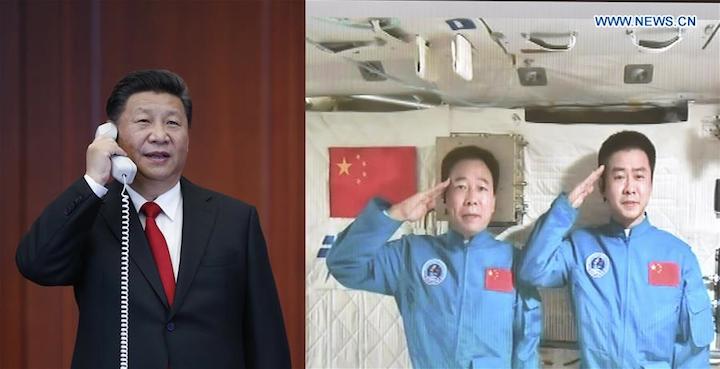
Combination photo taken on Nov. 9, 2016 shows Chinese President Xi Jinping (L) talks with the two astronauts, Jing Haipeng and Chen Dong, in the space lab Tiangong-2, at the command center of China's manned space program in Beijing, capital of China.
BEIJING, Chinese President Xi Jinping on Wednesday talked with the two astronauts in the space lab Tiangong-2, at the command center of China's manned space program in Beijing.
The two astronauts, Jing Haipeng and Chen Dong, embarked on their 33-day journey, the longest mission in the country's manned space program to date, onboard the Shenzhou-11 spacecraft on Oct. 17. They entered Tiangong-2 on Oct. 19.
Xi expressed his sincere greetings to the two astronauts on behalf of the Central Committee of the Communist Party of China, the State Council, the Central Military Commission, and people of all ethnic groups in the country.
"You have lived in space for more than half a month, and this is the third manned space mission Comrade Haipeng has undertaken and the first time for Comrade Chen Dong to enter space," Xi said during the video call. "All the Chinese people care about you very much."
Responding to Xi's inquiries about their work, health and living conditions, Jing, commander of the crew, said they felt very well and were working as scheduled.
Jing told the president that they could even watch the China Central Television (CCTV) evening news bulletin, or "Xinwen Lianbo," in space.
"China's manned space program has reached a new height. Chinese astronauts now enjoy better working and living conditions in space. We feel very proud of our great motherland," Jing said.
Chen said he had adapted to the zero-gravity environment in space, and his daily life and work there was normal. He vowed to work harder and fulfill the remaining tasks.
Xi said he was delighted to learn the astronauts were in good condition, speaking highly of their coordinated efforts in facing difficulties.
The president said he hoped the two astronauts would keep up the good work through close cooperation and careful operation, so as to complete their mission.
Shenzhou-11, China's sixth manned spacecraft, was launched on Oct. 17 from northwest China's Gobi Desert.
It approached Tiangong-2, which was launched into space on Sept. 15, and automatically docked with the space lab on Oct. 19.
The mission aims to transport personnel and materials between Earth and Tiangong-2, and test the ability to successfully meet, dock and return.
Other objectives include aerospace medical experiments, space science experiments and in-orbit maintenance.
Before the talk, Jing and Chen carried out an in-orbit maintenance test using man-robotics coordination, the first ever such test in space.
Quelle: Xinhua
-
Update: 13.11.2016
.
Space Journal: Entry 7 -- Chinese farmers in space
Greetings to everyone. Today (Nov. 11) is my 24th day onboard Tiangong-2. I am Xinhua space correspondent Jing Haipeng.
I have heard that people are curious about the gardening tests we are doing up here, so let me tell you about how we are growing lettuces.
We did some routine gardening today. We tested the moisture and nutrient content in the culture substrates, and provided our plants with light and air.
We use a device to test if the plants need more or less moisture, a lower reading indicates that our lettuces need watering. We also inject air onto the roots of the lettuces, which helps them grow better.
We are like farmers in space, and we have to spend at least 10 minutes everyday tending to our lettuces.
The culture substrate we use is not like the soil on Earth, it is a specially-developed mineral material.
We began the gardening tests on our second day in Tiangong-2. First we had to install the cultivation device, which came in individual parts -- like Lego. We installed the completed device inside a white box.
Then we watered and sowed.
In the lead up to this mission, some of the seeds had been processed into little balls and put into individual unit cells. Lettuce seeds are smaller than sesame seeds, so they had to be covered in a special coating to form mung-bean size balls, which made it easier for us to handle them.
The balls were designed so that the seeds separate from the coating when they come into contact with water, however, we have found that the coating affects the sprouting process slightly.
Sowing seeds in space is also different from on Earth, where we sow the seeds first and then water them. As the culture units in space are a solid material we water first and sow the seeds into the soft base.
After this, we put a piece of plastic over the culture device, which works like a propagator and prevent water loss.
On the fifth day onboard the space lab, the seeds had sprouted. My brother Chen Dong and I were very excited and relayed the news to our ground team. We took a lot of pictures.
After the seeds sprouted, we took off the protective film and turned on the lights. We used red, blue and green light, with red as the strongest color.
We also had to thin out our seedlings on the sixth day after we had sown them. My brother Chen and I think the lettuces look very fresh and greener than those grown on Earth.
We used tweezers to pull out the weaker-looking sprouts and left two in each unit cell. We had to do this very carefully as the sprouts were still very delicate. Three days later, we did a second round of thinning and watering. This time, we only left one sprout in each cell.
We do not need to water the plants everyday. According to agricultural experts, we only need to water the plants five times. We use syringes to water the roots.
Also, we have to observe, take pictures and test the lettuces everyday.
The lettuces have been growing well so far, and we are satisfied with our work.
Some people have asked if the sprouts grow in a different direction in space. All our lettuces have grown upward, like on Earth, but it does seem that they are a bit taller.
Tuesday will be the last day we tend to our vegetables in-orbit. We will take samples from the plants -- leaf cuttings and sections of the roots, keep them in a low-temperature storage device and bring them back to Earth.
Another question has been whether the lettuces will be edible.
This time, these vegetables are just for experimental tests, and will not be eaten. However, I believe that after further research, space-grown vegetables will be edible. I see a future where astronauts eat the vegetables they have grown in space.
Quelle: Xinhua



